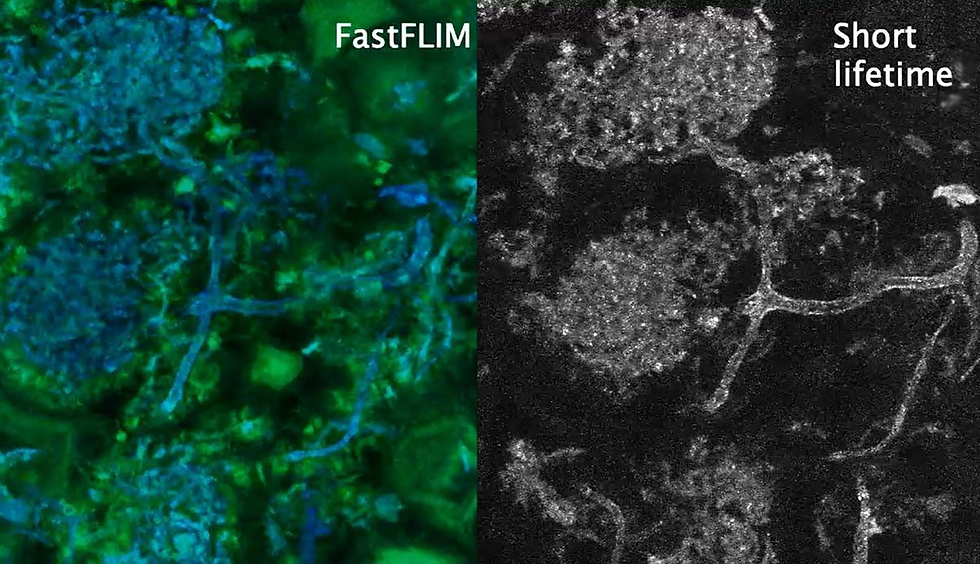Discovery of Fossilised Fungal Species Sheds Light on Plants’ First Steps onto Land
- Gauri Khanna
- 12 hours ago
- 3 min read
Too long to read? Go for the highlights below.
Fossils from Scotland’s Windyfield Chert reveal one of the earliest known nutrient-sharing partnerships between plants and fungi.
Advanced microscopy techniques have identified a new fungal species, Rugososporomyces lavoisierae, embedded within a 407-million-year-old plant.
The findings illuminate how symbioses helped early plants adapt to life on land.
The first plants to venture onto dry land faced a harsh world. Around 407 million years ago, long before forests emerged, the Scottish Highlands hosted steaming wetlands reminiscent of parts of Yellowstone National Park today. In this landscape, early plants lacked true roots, soils were unstable, and nutrients were difficult to extract. Yet these pioneers survived, and a newly described fossil suggests that fungi played a decisive role in that early success.
Researchers from Cambridge University, examining a slice of Windyfield Chert (a rock unit renowned for its exceptional preservation of Early Devonian ecosystems) have identified Rugososporomyces lavoisierae, a symbiotic fungus entombed within the tissues of Aglaophyton majus. This microscopic association, preserved for more than 400 million years, represents one of the earliest known examples of mycorrhiza: a nutrient-exchange system still found in over 85% of living plants. It offers rare insight into how plants and fungi first collaborated to colonise land.
A Window into the Devonian Landscape
For decades, the Windyfield and neighbouring Rhynie Cherts have offered a near-perfect snapshot of a vanished world. Their fossils were created when silica-rich water from local hot springs inundated wetlands, entombing plants, fungi and arthropods in place. Traditional microscope thin-sections have allowed scientists to reconstruct this ecosystem in remarkable detail, but they have struggled to resolve finer fungal structures.

A new combination of confocal microscopy, fluorescence lifetime imaging (FLIM) and Raman spectroscopy has changed that. By analysing the light emitted from fossilised tissues, signals that act as chemical fingerprints, the team could distinguish fungal hyphae from plant cells in three dimensions. According to the researchers, this is the first time such techniques have been applied to fossils, opening new possibilities for identifying long-vanished organisms whose DNA has not survived.
The resulting images reveal arbuscules: bush-like structures formed by fungi inside plant tissues to exchange nutrients. Their presence shows that R. lavoisierae was not feeding on decaying material but formed a cooperative partnership with its host.
Life Without Roots
What makes the discovery striking is where these arbuscules are found. Modern mycorrhizae occur in plant roots, yet Aglaophyton majus had none. Instead, it produced rhizoids, delicate filaments that offered little more than anchorage. The fossil suggests the fungus colonised tissues above the soil surface, a pattern that today survives only in some liverworts and hornworts.

The arrangement implies that nutrient-sharing partnerships developed before true roots evolved. Early terrestrial plants, poorly equipped to extract phosphorus or water from the ground, appear to have relied on fungi as external miners. In return, the fungi received sugars produced by photosynthesis. This mutualism would have eased the transition from aquatic to terrestrial life at a time when ultraviolet radiation, nutrient scarcity and desiccation made survival difficult.
Understanding when and how these associations emerged remains an open question. Some freshwater green algae, the closest relatives of land plants, possess part, but not all, of the genetic toolkit needed to accommodate fungal partners. This hints that crucial symbiotic traits evolved after plants diverged from their algal ancestors, possibly during the earliest phases of terrestrialisation.
Reconstructing Immune Responses in Deep Time
One unresolved puzzle concerns how ancient plants learned to tolerate fungal invasion. Modern plants typically activate immune responses against unwanted microbes, forming chemical barriers that limit infection. Symbiotic fungi suppress these defences to establish stable partnerships. Whether early plants possessed similar mechanisms is unknown.
The team suspects that traces of these defensive reactions might be preserved within the Devonian cherts. If so, advanced imaging could reveal how immune responses evolved during the early stages of plant–fungus co-evolution. Detecting such signals would mark a significant leap in reconstructing the biology of ancient ecosystems.
Looking Ahead
The Windyfield Chert continues to refine our understanding of life’s early chapters. The identification of Rugososporomyces lavoisierae demonstrates that plants’ first steps onto land were supported by fungal partners capable of supplying essential nutrients long before roots appeared. As researchers extend these imaging techniques to other fossils, new details will emerge about how plants and fungi shaped the terrestrial world that followed.




